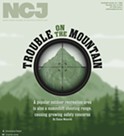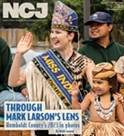[
{
"name": "Top Stories Video Pair",
"insertPoint": "7",
"component": "17087298",
"parentWrapperClass": "fdn-ads-inline-content-block",
"requiredCountToDisplay": "1"
}
]
My brief crime spree included breaking and entering, grand larceny, vandalism, attempted murder, wire fraud, resisting arrest and, finally, indecent exposure.
However, as a criminal, I have a line I will not cross. This gives me a sense of moral superiority over regular low-life criminals. That line is: I will not harvest sea palm (Postelsia palmaeformis) without a permit.
Sea palm is a kelp classified within the brown algae. It clings to rocks in the surf zone. Its strong and very flexible stem (the "stipe") is topped by many palm-frond-like blades. When a wave hits, the "palms" bend over. And as the wave recedes, they sequentially pop back up to a standing position. It always looks to me like a crowd of 2-foot-tall people with crazy hair and no sense of personal space climbing onto a rock.
This motion isn't just some trivial artifact of life in the surf zone. The movement increases the blades' overall exposure to sunlight, which increases photosynthesis. So, in effect, the sea palm derives energy from the motion of the surf. And because the surf is created by winds that were created by energy from the sun, the sea palm double dips the sun's energy.
To resist the pounding surf, sea palms have a very strong attachment structure — a superficially root-like mass called a "holdfast." Their most secure attachment place is on bare rock. However, many sea palms end up attached to mussels and barnacles. And because they can attach to these animals more tightly than the animals can attach to the rock, they often tear loose and take the unfortunate mussels and barnacles with them.
A premature tearing loose may seem like a waste of a sea palm. But don't cry for them. They have produced bare rock for the next generation to cling to.
As much as the sea palm benefits from the motion of the surf, it actually spends much of its life exposed to the atmosphere during low tides. These calm periods are critical for their reproductive phase, which is pretty complicated.
There is no sex for the palm-like generation, which is called the "sporophyte." The blades produce spores that drip down to land under the aggregation of mature sea palms. The spores are actually able to swim, but they normally attach right below the parent. Each spore then grows into either a male or female, which produce sperm and eggs, respectively, which sounds like a terrible breakfast. So, these microscopic "gametophytes" reproduce sexually and the fertilized eggs grow into new sea palms.
The sea palm is an annual species. This means they complete their reproductive cycle every year and then die when eventually knocked loose by high surf. After the first big swells of the season, you'll see a lot of bedraggled sea palms washing up — often with attached mussels and barnacles. The new offspring then grow to replace the previous generation.
It's illegal to harvest sea palm without a permit because careless harvesters often clip too much of the edible, spore-producing blades. This interferes with reproduction and because the plant is an annual with a very limited dispersal of spores, whole colonies may be quickly wiped out.
Anyway, at my preliminary hearing, the cops apologized for unnecessarily Tasering my bare ass. (But who can blame them? It is a super sweet target.) And when I explained that my crime spree was just research for a story about sea palms, the district attorney dropped the charges.
So, the moral of the story is: If you get busted harvesting sea palm without a permit, do not moon the cops.
Biologist Mike Kelly (he/him) is also the author of the book Tigerfish: Traditional and Sport Fishing on the Niger River, Mali, West Africa. It's available at Amazon or everywhere e-books are sold.
Speaking of Sea Palms, Kelp
-

Target Trouble, Schneider and Dinsmore Updates, Ice Cream and Kelp
Jan 12, 2024 -

Purple Urchin Profits
Aug 5, 2021 - More »
more from the author
-
Hot Tomcod Action
- Apr 18, 2024
-
Wandering Meatloaf
- Mar 7, 2024
-
Barnacle Envy
- Nov 16, 2023
- More »

































